As the site is updated, each listing includes the shipping cost. Some listings which I have not updated still give you calculated shipping costs based on weight and size of package. (In the sections I have updated) If you select several different listings, we will consolidate your order and charge you the actual cost of the entire package. The shipping over charge will be refunded to you, when your order is shipped.
STARFISH MANY VARIETIES FOR CRAFTING TO COLLECTING
STARFISH
The asteroid body has the form of a flattened star with arms (rays) generally numbering 5 or a multiple of 5. It is rare to see six or other number of arms. The arms join a disc like body.
The upper surface of the arm has the spines and other Enchinoderm features. There is usually a red eye spot at the tip of each arm.
The under side of the sea star has a mouth in the middle of the disc and there is an open groove from the mouth to the tip of the arm. Two or four rows of tube feet are found in each groove.
Sea stars travel on the tube feet. The tube feet has suckers that reach ahead and attach to solid objects; thus pulling the sea star forward. The burrowing sea star lack suckers and only push the sea star forward.
Sea stars feeding varies with the species. Most feed by extending their stomachs thru their mouth to envelope their food.
Sea stars can regenerate arms. When an arm is damaged, it is shed at a point close to the central disc. (this is why the species you receive have arms of varying development). If the arm surface is cut slightly, it can usually heal over. In some species, the lost arm can generate a central disc; thus creating a new sea star.
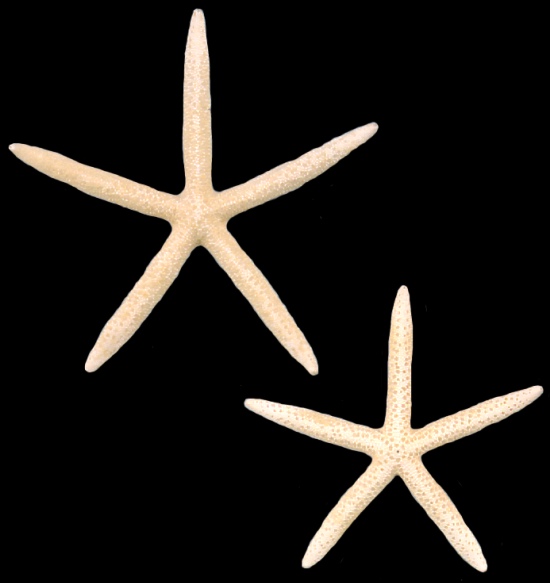
WHITE STARFISH
Typically, the larger the starfish, the more imperfections it has. This lack of symmetry in many starfish is due to their ability to regenerate lost arms, which explains why some arms may be longer than others.
B1-18
A White Starfish measuring 2 to 3 inches........ .49
B2-18
A White starfish measuring 3 to 4 inches ........ .65
B3-18
A White Starfish measuring 4 to 5 inches........ .85
B4-18
A White Starfish measuring 5 to 6 inches ........ .95
B5-18
A White Starfish measuring 6 to 7 inches..... $1.09
B6-18
A White Starfish measuring 7 to 8 inches ....... $1.25
B7-18
A White Starfish measuring 8 to 9 inches....... $2.19
B8-18
A White Starfish measuring 9 to 10 inches....... $2.85
B9-18
A White Starfish measuring 10 to 11 inches....... $3.50
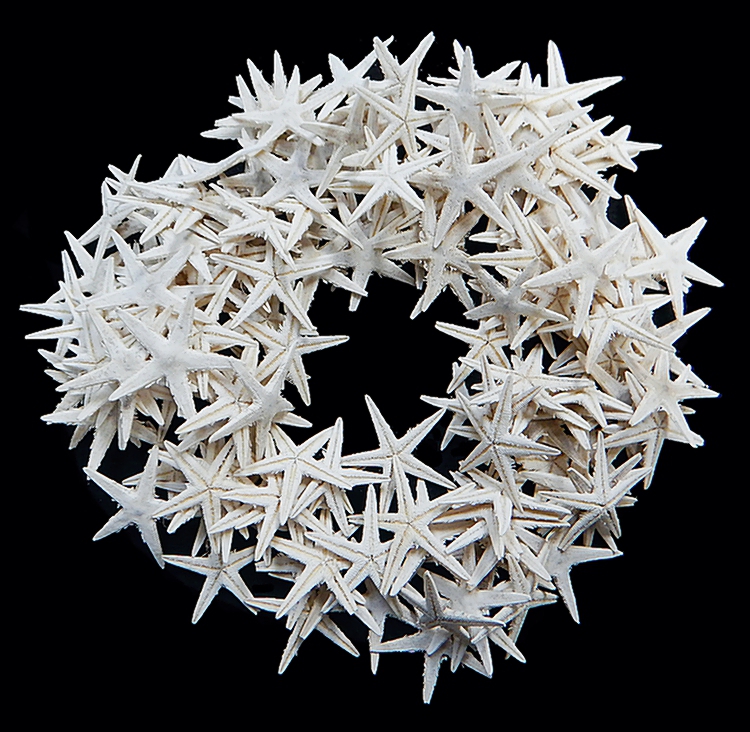
WHITE DYED STARFISH
WFS1-19
One White Dyed Starfish 1 1/2 to 2 inches... .06
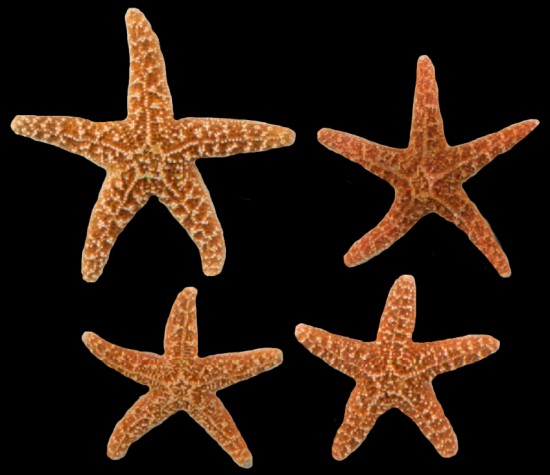
SUGAR STARFISH
The common starfish, common sea star or sugar starfish (Asterias rubens) is the most common and familiar starfish in the north-east Atlantic. Belonging to the family Asteriidae, it has five arms and usually grows to between 4 to 12 inches across, although larger specimens (up to 21 inches across) are known. The common starfish is usually orange or brownish in color, and sometimes violet; specimens found in deeper waters are pale. The common starfish is found on rocky and gravelly substrates (the surface or material on or from which an organism lives, grows, or obtains its nourishment) where it feeds on mollusks and other benthic invertebrates.
The common starfish is native to the northeastern Atlantic Ocean and its range extends from Norway and Sweden, through the North Sea, round the coasts of Britain, France, Spain and Portugal and southwards along the coasts of Africa to Senegal. It is largely absent from the Mediterranean Sea. It is also known from the western Atlantic where it occurs between Labrador and Florida and the Gulf of Mexico. It is capable of surviving in brackish water (a term used to describe water that is more saline than freshwater but less saline than true marine environments. Often these are transitional areas between fresh and marine waters. An estuary, which is the part of a river that meets the sea, this is the best known example of brackish water).
The common starfish feeds on a variety of benthic organisms. These include bivalve molluscs, polychaete worms, barnacles, gastropod molluscs, other echinoderms and carrion. When feeding on a mollusc such as a mussel, it attaches its tube feet to each shell valve and exerts force to separate them slightly. Even a gap of just 1 mm (0.04 in) is sufficient for the starfish to insert a fold of its stomach, secrete enzymes and start digesting the mollusc body. When the contents are sufficiently liquid, it brings its stomach back to its rightful position with the food inside. The common starfish has a well-developed sense of smell and can detect the odour of prey species such as the common mussel (Mytilus edulis) and crawl towards it. It can also detect the odour of the predatory common sunstar (Crossaster papposus), which eats other starfish, and take evasive action.
The common starfish is dioecious, which means that each individual is either male or female. In the spring, the females release their eggs into the sea. A moderate sized starfish is estimated to be able to produce 2.5 million eggs. The males shed their sperm and fertilization takes place in the water column. The larvae are planktonic and drift for about 87 days before settling on the seabed and undergoing metamorphosis into juveniles. Common starfish are believed to live for about seven to eight years. When well fed, the juveniles can increase their radius at the rate of slightly more than 10 mm (0.4 in) per month during the summer and autumn and slightly less than 5 millimeters (0.20 in) per month in the winter. An adult common starfish can survive starvation for several months although it loses weight in the process. One specimen shrank from a radius of 6 centimeters (2.4 in) to a radius of 3.8 centimeters (1.5 in) after starvation for five months.
The ciliate protozoan Orchitophrya stellarum is sometimes a parasite of the common starfish. It normally lives on the outer surface of the starfish feeding on sloughed-off epidermal tissue. It appears to become parasitic when the host starfish has ripe gonads and is a male. It enters the starfish through the gonopores, the orifices where gametes are released. There may be a pheromone that alerts it to the fact that the testes are ripe and causes it to change its behavour. As different species of starfish breed at different times of year, Orchitophrya stellarum may move from one species to another in accordance with their reproductive cycles. In the Atlantic Ocean, it may alternate between parasitize Asterias forbesi and Asterias rubens during the spring and summer and the winter host may be Leptasterias spp.. The ciliate has been found in the testes of all these species. When inside the gonad, it phagocytoses the sperm thus rendering the starfish infertile. Researchers have found a change in the sex ratios of affected populations with fewer males than females being present with the males being consistently smaller than the females.
Scientific classification
Domain: Eukaryota
Kingdom: Animalia
Phylum: Echinodermata
Class: Asteroidea
Order: Forcipulatida
Family: Asteriidae
Genus: Asterias
Species: A. rubens
E0-18
A Sugar starfish measuring 1 to 2 inches ........ .50
E1-18
A Sugar Starfish measuring 3 to 4 inches........ .99
E2-18
A Sugar Starfish measuring 4 to 5 inches...... $1.59
E3-18
A Sugar Starfish measuring 5 to 6 inches........ $1.89
E4-18
A Sugar Starfish measuring 6 to 7 inches........ $2.50
E5-18
A Sugar Starfish measuring 7 to 8 inches........ $3.75
E6-18
A Sugar Starfish measuring 8 to 9 inches ........ $5.00
E7-18
A Sugar Starfish measuring 9 to 10 inches ........ $5.95
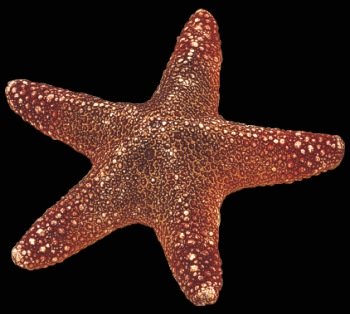
JUNGLE STARFISH
H0-4
A Jungle Starfish measuring 2 to 4 inches ........ .59
H1-4
A Jungle Starfish measuring 4 to 5 inches ........ .75
H2-4
A Jungle Starfish measuring 5 to 6 inches ........ .85
H3-4
A Jungle Starfish measuring 6 to 7 inches ........$1.00
H4-4
A Jungle Starfish measuring 7 to 8 inches........ $1.19
H5-4
A Jungle Starfish measuring 8 to 9 inches ........ $1.50
H6-4
A Jungle Starfish measuring 9 to 11 inches ........ $2.75
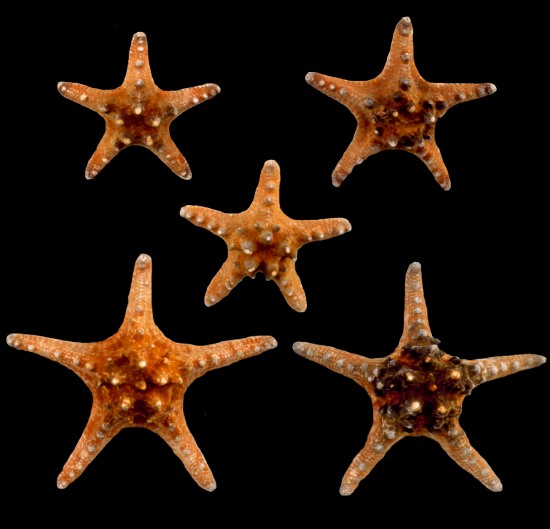
KNOBBY STARFISH
Scientific name: Echinaster echinophorus
F0-18
A Knobby Starfish measuring 1 1/2 to 2 1/2 inches ........ .29
F1-18
A Knobby Starfish measuring 2 1/2 to 4 inches........ .35
F2-18
A Knobby Starfish measuring 4 to 6 inches ........ .55
F3-18
A Knobby Starfish measuring 6 to 7 inches ........ .99
F5-18
A Knobby Starfish measuring 7 to 8 inches ..... $1.15
F4-18
A Knobby Starfish measuring 9 to 10 inches ........ $2.50
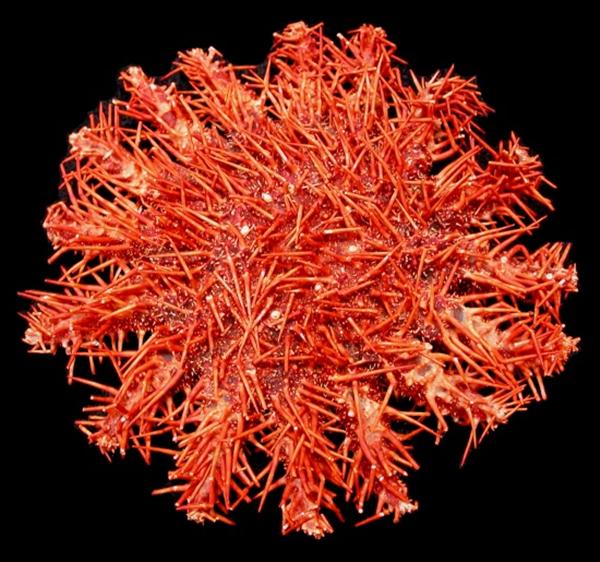
CROWN OF THORNS STARFISH
The Crown-of-Thorns starfish are deemed pests. Originating from the tropical Pacific near Australia, these starfish assail coral reefs and possess few natural predators.
The color of Crown-of-Thorns starfish may vary with the amount of sunlight exposure; they are often darker brown rather than reddish.
I0-19
A Crown of Thorns Starfish measuring 4 to 6 inches........ .15
I3-19
A Crown of Thorns Starfish measuring 6 to 8 inches........ .65
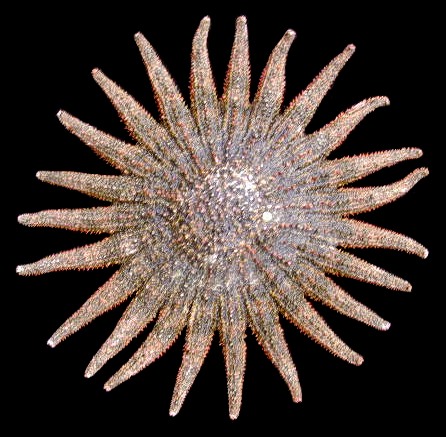
MULTI LEG OR SUN STARFISH
MS0-18
A Multi Leg starfish measuring 2 to 3 inches...… .45
MS1-18
A Multi Leg starfish measuring 3 to 4 inches ....... .59
MS2-18
A Multi Leg Starfish measuring 4 to 5 inches....... .69
MS3-18
A Multi Leg Starfish measuring 5 to 6 inches....... .85
MS4-18
A Multi Leg Sea star measuring 6 to 7 inches....... $.95
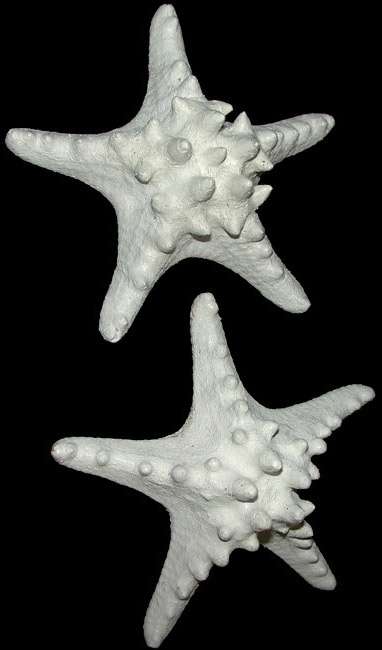
WHITE KNOBBY STARFISH
FW2-18
A White Knobby Starfish measuring 3 to 4 inches ........ .35
FW3-18
A White Knobby Starfish measuring 4 to 5 inches ...... .40
FW4-18
A White Knobby Starfish measuring 5 to 6 inches........ .89
FW5-18
A White Knobby Starfish measuring 7 to 8 inches........ $1.00
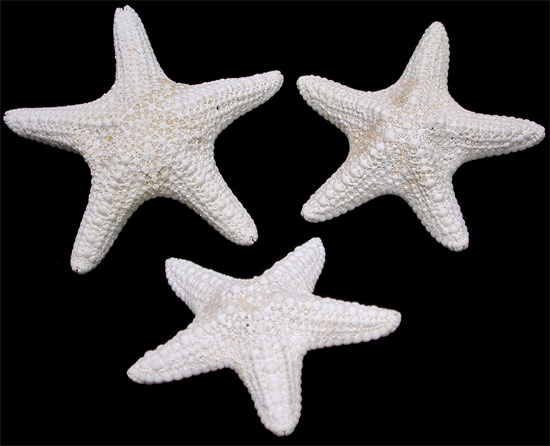
White Common Starfish
H1-18
A White Common Starfish measuring 3 to 5 inches ...... .35
H2-18
A White Common Starfish measuring at least 5 inches ...... .45
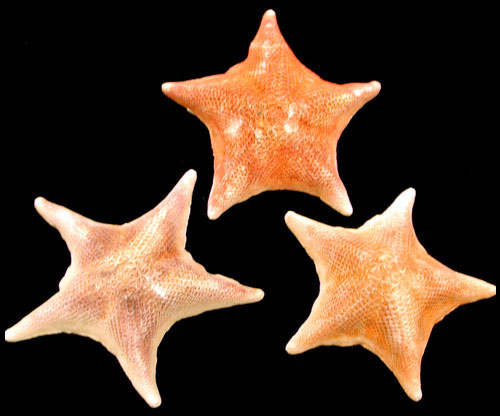
Bat Starfish
The Asterina miniata common name Bat Star, earns its name from its bat-like appearance. Its arms are not as distinctly separated as those of other starfish species, yet they are more defined than those of a sand dollar. Bat Stars display a diverse range of colors. Similar to other starfish, they reproduce by releasing their gametes into the water in a loosely synchronized manner, independent of the presence of other starfish. Bat Stars typically scavenge but can also exhibit predatory behavior. Small annelids reside in their oral grooves; while this seems not to affect the Bat Star, the benefits it may receive from this association remain uncertain.
Bat stars can reach up to 8 inches in diameter and inhabit the western coast of North America, from Alaska down to Baja California. They play a crucial role as scavengers in their ecosystems. A distinctive feature of bat stars is that the plates comprising their exoskeleton are so prominent and well-defined that they are often likened to shingles. Similar to how humans typically have five fingers, with some exceptions, bat stars usually have five arms but can have up to nine. They can be found from the intertidal zone to depths of approximately 950 feet. Bat stars occasionally prey on other starfish species. Conflicts between bat stars sometimes resemble arm wrestling matches, with each attempting to overlay its arm over the other's.
Scientific classification
Domain: Eukaryota
Kingdom: Animalia
Phylum: Echinodermata
Class: Asteroidea
Order: Valvatida
Family: Asterinidae
Genus: Patiria
Species: Patiria miniata
Binomial name: Patiria miniata
(Brandt, 1835)
(REF: Patiria miniata". Integrated Taxonomic Information System. Retrieved 29 November 2009.)(REF: sterina miniata". www.wallawalla.edu. Archived from the original on 23 May 2010. Retrieved 22 November 2009)(REF: sea stars". biology.fullerton.edu. Archived from the original on 23 November 2009. Retrieved 26 November 2009.)
.BS1-18
A Bat Starfish measuring 3 to 6 inches....... .50
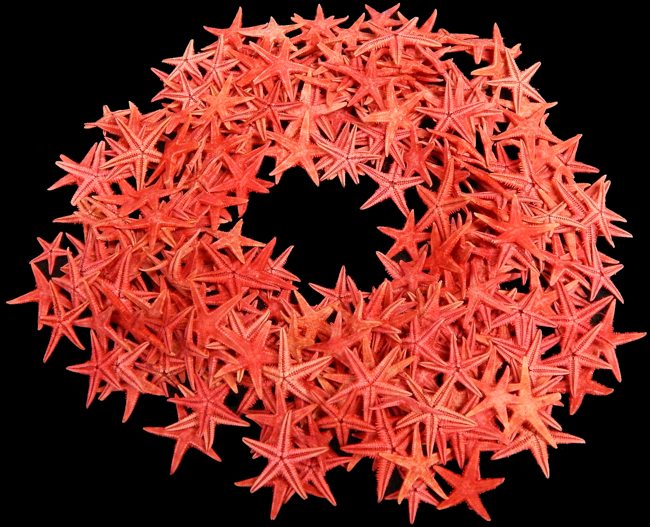
E2R-19
A Dyed Red Starfish measuring 1 to 1.5 inches..... .06
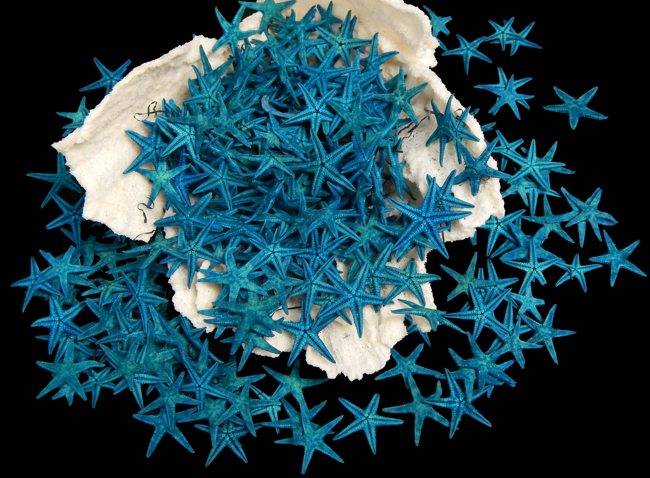
DYED BLUE STARFISH
E2B-19
A Dyed Blue Starfish measuring 1 to 2 inches..... .06
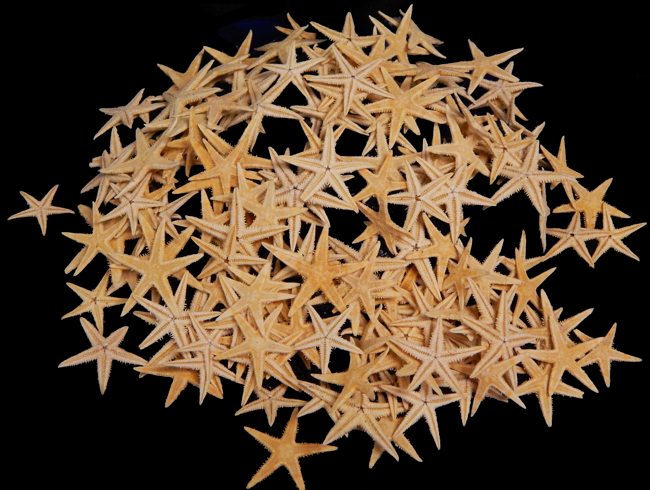
DYED TAN STARFISH
E1-19
A Dyed Tan Starfish measuring up to 1 inch..... .05
E2-19
A Dyed Tan Starfish measuring 1 to 1.5 inches ..... .06
E3-19
A Dyed Tan Starfish measuring 1 1/2 to 2 inches..... .07
E4-5-19
A Dyed Tan Starfish measuring 2 to 3.5 inches..... .12